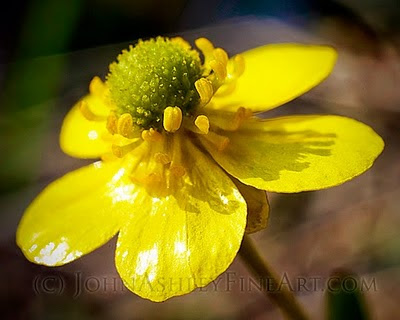By early April, the poppies have already peaked in northern Arizona, painting the Superstition Mountains in waves of gold. And over in central Texas, bluebonnets already blanket the shoulders along two-lanes in the Edwards Plateau.
Meanwhile in Montana, it might be snowing.
Meanwhile in Montana, it might be snowing.
But patience pays off in mid-April when tiny, yellow polka dots begin popping up in the piney woodlands and sunny pastures of northwestern Montana.
Buttercups are blooming -- our first little wildflowers of spring. Even with frosts each night, buttercups begin blooming when the average daytime air temperature climbs a few degrees above freezing.
Buttercups are blooming -- our first little wildflowers of spring. Even with frosts each night, buttercups begin blooming when the average daytime air temperature climbs a few degrees above freezing.
Measuring in at 3-4" tall with a 1" wide flower, sagebrush buttercups (Ranunculus glaberrimus) are the tiny harbingers of spring across Montana. The flowers are small but the buttercup family, Ranunculaceae, is large. Numbering around 2,000 species worldwide, there are about 25 native buttercups scattered across most of Montana. At least a dozen different buttercup species dot the valley and mountain habitats of Glacier Park.
The family name, Ranunculaceae is Latin for "little frog," a reference to several buttercup species that live in shallow ponds. (This name was given to buttercups by Pliny the Elder, 23-79 AD). Like the poison dart frog secretions used on blowdarts, most buttercups are poisonous. They contain a glycoside, ranunculin, which turns into highly-toxic protoanemonin when crushed. The Okanagan-Colville Indians used buttercup toxin by rubbing the plants and flowers on their arrow points.
Wildlife and livestock can safely eat young buttercups. But by the time flowers are produced, the plants produce a highly unpalatable juice and are avoided by most intelligent animals -- of course, this excludes some domestic sheep. The plants eventually loose their toxicity when they cure out in June, so hay is considered safe.
Some non-native European species, like bur buttercup (Ranunculus testiculatus) and tall buttercup (Ranunculus acris), have invaded most of Montana and found their way onto the state's "noxious weed" hit list.
Some non-native European species, like bur buttercup (Ranunculus testiculatus) and tall buttercup (Ranunculus acris), have invaded most of Montana and found their way onto the state's "noxious weed" hit list.
 Our native harbinger of spring follows the receding snow. It can bloom quickly because it produced the flower buds last fall. These buds lay dormant all winter under the snow, waiting for a jolt of warmth and sunshine.
Our native harbinger of spring follows the receding snow. It can bloom quickly because it produced the flower buds last fall. These buds lay dormant all winter under the snow, waiting for a jolt of warmth and sunshine. In the lower and sunnier elevations of southwestern Montana, in the Bitterroot and Missoula Valleys, native buttercups are normally jolted into bloom during mid-March. This average date is based on buttercup specimens that were collected over the last one hundred years, as documented in the herbarium collection at the University of Montana.
However, buttercups in these southwestern valleys have bloomed earlier during some recent, warm winters. In 2005, buttercups were seen blooming by January 25th. In 2006, their local harbingers of spring were documented blooming on January 11th.
That's just too early.
From a 14-year study in Missoula, researchers found that 24 of 32 native wildflowers, including sagebrush buttercup, are blooming earlier each year, by an average of 0.6 days per year, or a total of 8 days over the course of the study. A rise in average March temperatures accounted for 37% of the advance, and a decrease in precipitation during December and January accounted for 47% of the advance.
That's just too early.
From a 14-year study in Missoula, researchers found that 24 of 32 native wildflowers, including sagebrush buttercup, are blooming earlier each year, by an average of 0.6 days per year, or a total of 8 days over the course of the study. A rise in average March temperatures accounted for 37% of the advance, and a decrease in precipitation during December and January accounted for 47% of the advance.
Winter and spring snows may wear thin in western Montana, but our rivers need the frozen mountain snow pack to keep them flowing all summer. The patient buttercups -- and the rest of us -- will be better off in the long run if spring waits until April.
Okay, maybe March.
Behind the lens: My big-boy tripod head rendered my tripod useless for these macro photos. And just to make hand-held close-ups more challenging, 10 mph wind wind gusts kept these little one-inch flowers bobbing and weaving.
Okay, maybe March.
Behind the lens: My big-boy tripod head rendered my tripod useless for these macro photos. And just to make hand-held close-ups more challenging, 10 mph wind wind gusts kept these little one-inch flowers bobbing and weaving.


